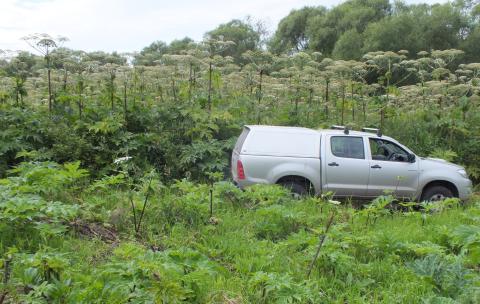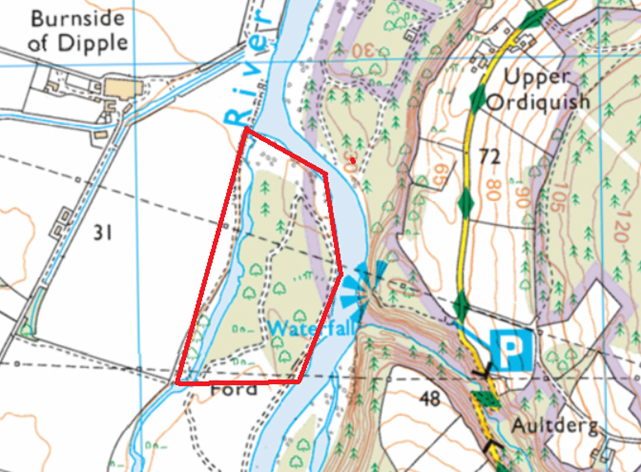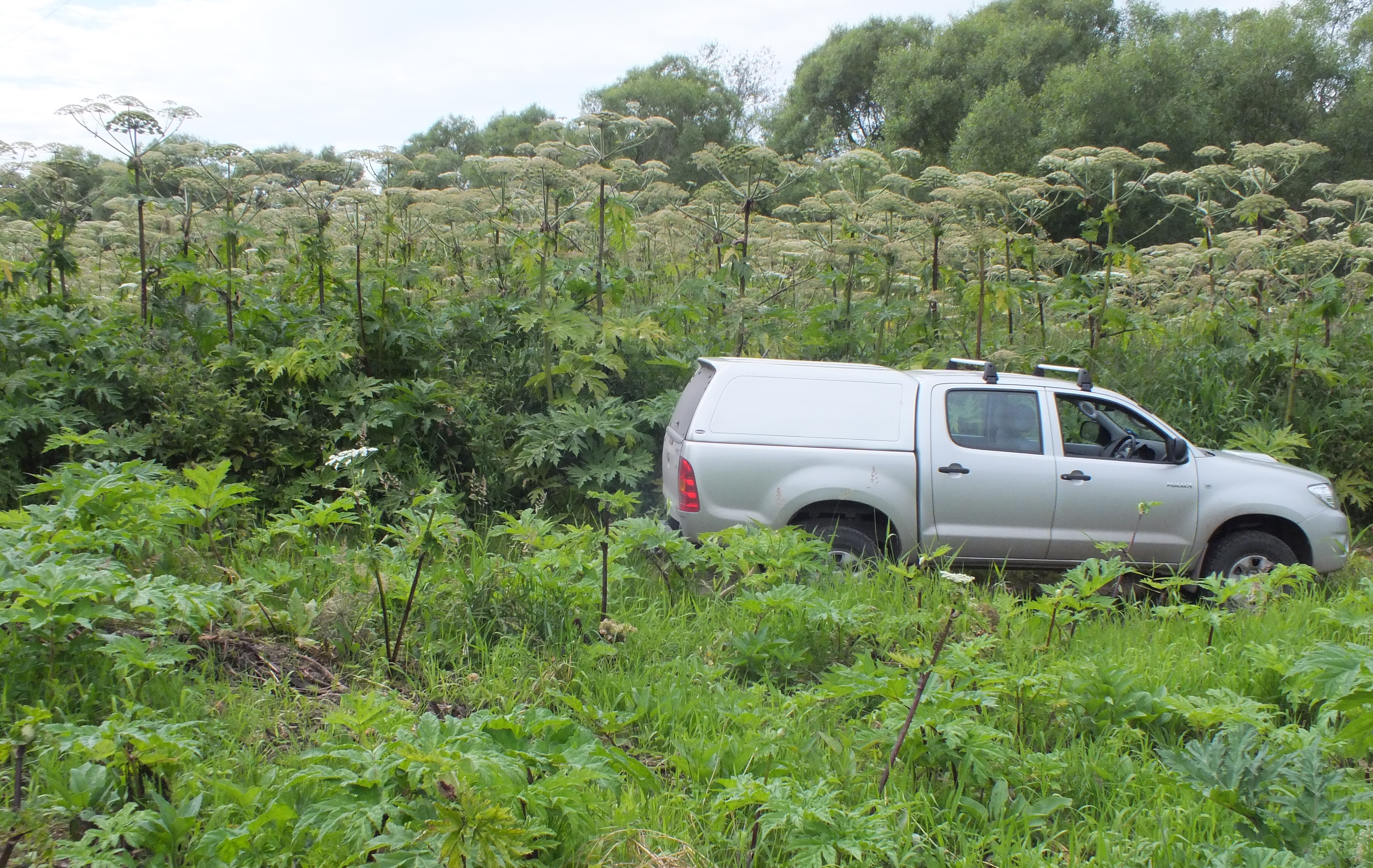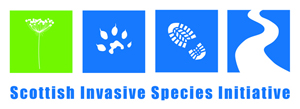Site Study: Giant hogweed control on Brae Water - River Spey at Fochabers

Summary
The Brae Water (Beat 3) site is a significant fishing beat on the River Spey and part of the Gordon Castle Estate. Giant hogweed present was identified as a priority for control by the Spey Fishery Board in 2012 and the Scottish Invasive Species Initiative in 2018. The site is not the most upstream giant hogweed location on the River Spey - but it is the most upstream ‘hogweed forest’ location and is a seed source for downstream locations, as well as presenting a public safety risk and limiting access of the site at Brae Water.
Limited control had been undertaken at the site prior to 2018 - this was undertaken principally to protect access to the river along established paths and tracks for water users. Since 2018, the Scottish Invasive Species Initiative has undertaken annual control at Brae Water as part of a wider programme of invasive non-native plant management across the Spey catchment.
This approach has markedly reduced the abundance of giant hogweed at the site and also the effort (time) and chemical volume needed to deliver control. The project has deployed a combination of appointed contractors, staff from the Scottish Invasive Species Initiative and the Spey Fishery Board, volunteers and bailiffs to complete this work.
Annual monitoring and control will be required at Brae Water for a number of years from 2023 onwards. This will treat giant hogweed seedlings which will emerge from the seedbank present in the soil and prevent any remaining mature plants setting seed. By preventing plant maturation and seed setting, the seed bank will be diminished and the infestation reduced. This will take several years but after initial control efforts this is now a more manageable task.
1. Site description
Beat 3 of the Brae Water, owned by Gordon Castle Estate, is located on the main stem of the River Spey, south of the A96 road bridge at Fochabers (grid reference NJ 333 565). The main area of control, located on the left bank, is 560m long and 250m wide, covering an area of approximately 12ha. The site location is shown in Map 1.
In 2018 approximately 80% of the total area was dominated by dense stands of giant hogweed and Japanese knotweed. The remainder of the site was rough grassland interspersed with lower densities of giant hogweed and Japanese knotweed.
Within the Scottish Invasive Species Initiative partnership the Spey catchment is covered by the Spey Fishery Board.
The River Spey is designated a Special Area of Conservation (SAC) – with qualifying interests being the Atlantic salmon, freshwater pearl mussel, sea lamprey and otter.
Map 1: Location of giant hogweed control site at Brae Water (Beat 3) on River Spey

2. Background
It is unclear when giant hogweed became established on the River Spey catchment. However, the plant is now widespread and, whilst the Brae Water site is not the uppermost infestation on the river, it represents the most upstream ‘hogweed forest’ on the river. As such, this location and the giant hogweed infestation present is a significant seed source for downstream sites.
The Brae Water site was first identified as a priority for control in 2012, during a Spey Fishery Board survey of invasive plants in the Spey catchment. At that time, giant hogweed at the site was severely restricting safe access to the river for angling and mature plants were blocking roads and paths across the entire area (see Figure 1). The infestation posed a significant health and safety risk to the public and water users due to the phototoxic hazard presented by the sap from giant hogweed plants.
Limited control work had been undertaken since 2012 – principally to keep access routes to the river clear for anglers – but this did not extend far beyond the roads and paths on the site. The remainder of the infestation was left largely untreated.
In 2018 the Scottish Invasive Species Initiative reconfirmed the priority for giant hogweed control at Brae Water and control was started in that year.

Figure 1: Extensive giant hogweed infestation at Brae Water (Beat 3) – July 2012
3. Management works
The Scottish Invasive Species Initiative started control work at Brae Water in 2018.
Due to the scale of infestation, contractors were appointed to undertake the initial herbicide control works on the site. Project and Spey Fishery Board staff and volunteers worked alongside the contractors to complement their efforts and increase the extent of control delivered. After herbicide control, Scottish Invasive Species Initiative and Spey Fishery Board staff and volunteers returned to the site a little later in the season to chop flowering heads. This prevented additional seed dispersal to the site, its seedbank and downstream locations.
This process and combination of controls was repeated in 2019, 2020, 2021 and 2022.
Table 1 (below) shows a summary of the control treatments.
Table 1 – Summary of control treatments (2018 – 2022) at Brae Water (Beat 3), River Spey
| Year | Invasive Species | Work Completed by | Control Work - Date and Method | |||
|---|---|---|---|---|---|---|
| 2018 | Giant hogweed | Contractors, project and Spey Fishery Board staff, volunteers | Foliar spray – April Cutting – June |
|||
| 2019 | Giant hogweed | Contractors, project and Spey Fishery Board staff, volunteers | Foliar spray – May Cutting – June |
|||
| 2020 | Giant hogweed | Contractors, project and Spey Fishery Board staff, volunteers, ghillies | Foliar spray – May Cutting – July |
|||
| 2021 | Giant hogweed | Contractors, project and Spey Fishery Board staff, volunteers | Foliar spray – May Cutting – June |
|||
| 2022 | Giant hogweed | Contractors, ghillies | Foliar spray - May |
4. Results
4.1 Invasive species abundance
Following treatments and control in 2018, 2019, 2020, 2021 and 2022, giant hogweed abundance has reduced and the age class of the giant hogweed plants still present on the site has changed. In 2018 there was a full range of plant age classes present, with the majority fully mature and able to flower and set seed that year. By 2022 the majority of plants were <1 year old, with very few mature plants remaining and no flowering heads emerging. The changing age class of the giant hogweed is a promising sign, indicating that annual control is effective and ensures no giant hogweed plants are surviving to maturity and setting seed. This is encouraging progress but a significant infestation of giant hogweed still remains within the site.
4.2 Chemical usage
Foliar spray applications of glyphosate were made in 2018, 2019, 2020, 2021 and 2022 using a backpack sprayer and delivered at a concentration of 20ml per litre.
Table 2 (below) shows the total volume of glyphosate used in each control year.
Table 2 – Volume of glyphosate to control giant hogweed (2018 – 2022) at Brae Water (Beat 3), River Spey
| Site Name | Glyphosate used per year (litres) | ||||
|---|---|---|---|---|---|
| 2018 | 2019 | 2020 | 2021 | 2022 | |
| Brae Water (Beat 3) | 16.0 | 4.0 | 4.4 | 2.4 | 2.2 |
4.3 People effort
Control at Brae Water was delivered by annual combinations of appointed contractors, Scottish Invasive Species Initiative and Spey Fishery Board staff, volunteers and, in 2020, ghillies.
Table 3 (below) shows effort in terms of hours of control work per year for each method used and in total for all methods.
Table 3 – People hours used to control giant hogweed (2018 – 2022) at Brae Water (Beat 3), River Spey
| Site Name | Hours of control work by year | ||||
|---|---|---|---|---|---|
| 2018 | 2019 | 2020 | 2021 | 2022 | |
| Brae Water (Beat 3) - Herbicide | 110 | 70 | 67 | 62 | 54 |
| Brae Water (Beat 3) - Cutting | 12 | 6 | 4 | 4 | 0 |
| Brae Water (Beat 3) - all methods | 122 | 76 | 71 | 66 | 54 |
5. Conclusions and Progress Made
Work at Brae Water (Beat 3) from 2018 to 2022 has reduced the abundance of giant hogweed at the site and the time and chemical volumes required to deliver annual control. This is encouraging, but there remains a significant infestation at the Brae Water site and further control work will be required in the coming years.
Established giant hogweed stands generally take at least 3-4 years of continuous effective treatment in order to reduce plant density as the various age classes are treated. Our approach - delivering chemical control to emerging plants, combined with cutting of flowering heads to prevent seed dispersal - will annually remove young and maturing plants, progressively deplete the seed bank, prevent dispersal from the site downstream and continue to reduce the giant hogweed population present on the site. However, giant hogweed seeds can remain viable in the soil for many years (up to 10 years) and so ongoing control will be required.
Progress is also shown in the hours of work needed to treat the giant hogweed infestation (see Table 3). The hours required to deliver control has reduced by 56% from 2018 to 2022. We expect further reductions in time taken to deliver control, but at a relatively extensive site there will always be a certain amount of effort needed to cover the ground and treat plants wherever they are found.
The chemical volumes used to complete treatment each year has reduced by 86% from 2018 to 2022 (see Table 2). This reflects the reduced giant hogweed abundance at the site (there are fewer plants to treat). The slight increase in chemical use in 2020 is a result of the delayed start of contractor control due to the Covid19 pandemic, meaning that plants were larger when control commenced in early June. A larger plant requires more chemical for control to be effective.
The combination of contractor, project and Spey Fishery Board staff, volunteers and ghillies has been effective to deliver control. In the Scottish Invasive Species Initiative our approach is to deploy contractors to the worst sites initially, with a view to transition towards project, partner, volunteer and/or land manager control when the scale of the problem has been reduced. In the coming years we will seek to implement that transition at Brae Water.
6. Next Steps
The giant hogweed infestation at Brae Water is well established and has been present for many years. This means that a significant seed bank is present at the site and giant hogweed seedlings will emerge annually for a number of years from 2023 onwards.
The primary objective at the site is to continue to control annually emerging plants to prevent them maturing and setting seed. If achieved, the extent of regrowth will decline as the seed bank is progressively exhausted and, in time, the site will move towards being clear of giant hogweed. However, this will take a number of years to achieve and will require effective annual control and monitoring. Ensuring that no plants set seed at Brae Water will also prevent re-infestation of other control areas further downstream.
The control effort (hours) and chemical volume required to deliver control has reduced since 2018. However, control levels similar to those recorded in 2022 are anticipated over the coming years – even when and if plant abundance continues to be reduced.
Now that these annual and recurring tasks have been significantly reduced and are more manageable and predictable, discussions with the landowners will be initiated to transfer or agree on future responsibilities for management of the site.
Once achieved, this transfer or sharing of responsibilities will allow future giant hogweed control projects to target new sites downstream, safe in the knowledge that control at Brae Water is in hand.
Further Information
Contact: [email protected]
